AlgiNot: A Stable, Reliable Preliminary Impression Material for Improved Productivity
Andrew Shannon, DDS
Performing indirect restorative dentistry is challenging. Aside from the clinical skills required to properly prepare a case, there is also the time-consuming provisional stage, which is critical to the case’s success. Even with proper time and care, it is difficult to deliver a well-fitting temporary predictably and cost-effectively.
A properly fitting provisional is a key factor in the ultimate result. It not only maintains contact points and occlusal stability, but also creates an ideal soft tissue response environment by providing a detailed marginal fit. Although fabrication methods such as vacuum form stints and heated acrylic buttons are available, using alginate in conjunction with plastic disposable trays has been the most popular method of preliminary impression-taking.
Although popular, alginate materials are a relatively unstable means for creating and replicating provisionals. Their poor dimensional stability dictates that they must be poured up immediately, which is often a tall order for a busy practice. Moreover, if the patient does not bite down on the impression matrix containing the self-curing resin in perfect accordance with the originally recorded bite, the only template is destroyed.
When dental manufacturers began to realize how important it is for clinicians to have a stable, accurate, multi-use, and strong preliminary impression material, they started to develop products that would meet the dentists’ needs. Polyvinyl siloxanes (PVS) have become popular for this application because they are dimensionally stable and offer a reliable means of creating temporary restorations. During the past few years, the author has been using a heavy-body PVS tray material for making temporization matrices, but this practice leads to additional high-cost inventory.
Preliminary Impressions We Can Count On
Creating a temporary comes at the end of a focused session of completing the needed prosthetic steps, and all dentists would like nothing better than to be able to make temporaries in a quick, simple, and predictable manner. Kerr Dental (Orange, CA) responded to this need with the development of AlgiNot™. The clinical applications of AlgiNot for preliminary impressions include:
- crown-and-bridge provisionals
- opposing dentition models for full arch crown-and-bridge cases
- case study models
- orthodontic models
- retainers and splints
- sports guards
- whitening trays
AlgiNot is a single-vinyl A-silicone. Its efficiency compared to the time an assistant spends mixing alginate and cleaning up the mess (not to mention the potentially hazardous powder and repetitive hand-mixing) makes it an extremely cost-effective, desirable alternative. And there are numerous other benefits, including multiple uses from a single impression matrix, a smooth surface for ease in polishing models, and multiple automix dispensing options. These advantages combine to save a tremendous amount of time, giving the dentist the opportunity to accommodate more patients.
Models can be poured immediately or delayed up to a few months without loss of accuracy. From start to finish, the cartridge delivery system allows 1 minute of working time with a removal time of 21¼2 minutes. (Add 15 seconds to each of these times for the Volume™ delivery.) AlgiNot offers excellent dimensional stability, detailed reproduction, and—extremely important for infection prevention protocol—it is compatible with most disinfection procedures.
Clinical Case 1
A woman presented who, while pleased with the color of her ceramic restorations, had lost tooth No. 12 to trauma and was now ready for replacement by an implant. She also had a failing veneer on tooth No. 11, which was planned to be restored at the same time as tooth No. 12 (Figure 1).
Before starting the case, preoperative impressions of both arches were taken using AlgiNot (Figures 2A and Figure 2B) to address the treatment region and to pour study models so that the case could be mounted on an articulator to equilibrate a stable occlusion.
The AlgiNot preoperative impression matrix accommodates any type of self-curing temporization material. The author prefers Fill-In™ (Kerr Corporation). This case shows just how quick and easy it is to duplicate the preoperative anatomical form of the tooth, and all in less than 2 minutes (Figure 3).
When it comes to shade-matching for temporaries, there are two options: choose the closest match from the temporary material shades provided (which, for most patients, makes the most sense) or customize the temporary with composite. This patient was pleased with the color, anatomical likeness, and polish of the Fill-In temporary, making the procedure quite cost-effective. For patients who are overly concerned with esthetics, the author would choose the latter option, first cutting back the temporary, then adding composite (Premise®, Kerr Corporation) to create a closer color match.
Clinical Case 2
Case 2 depicts a large failed composite restoration on tooth No. 16, which was planned for restoration with a ceramic onlay (Figure 4). Before the preparation, a preoperative AlgiNot impression matrix was taken and put aside (Figure 5).
After completing the prosthetic procedures and creating the ceramic onlay, the AlgiNot impression matrix was loaded with Fill-In temporary material and seated (Figure 6). After only 1½ minutes and with no difficulty, a remarkable degree of detail that replicated the preoperative condition was achieved (Figure 7).
Clinical Case 3
Case 3 depicts large failed restorations on teeth Nos.14 and 15 (Figure 8), which were planned for ceramic onlays. A preoperative impression matrix with AlgiNot (Figure 9) was taken and set aside. After preparing the tooth for the prosthetic and creating the onlay, the preoperative AlgiNot impression matrix was loaded with Fill-In (Figure 10) and seated. The AlgiNot impression matrix even captured the fracture of the original tooth structure on the distal of the lingual cusp (Figure 11A and Figure 11B).
This article was written by Andrew Shannon, DDS
For More Information
Kerr Dental
Phone: 1-800-537-7123
Web: www.kerdental.com
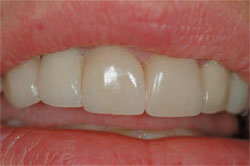 |  | |
| Figure 1 Preoperative views of tooth No. 12 (now ready for an implant) and the failing veneer on tooth No. 11. | Figure 2A and 2B Preoperative AlgiNot impressions of teeth Nos. 11 and 12 to address the treatment region and articulate the arches. | |
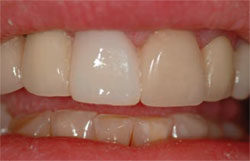 | 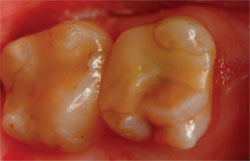 | |
| Figures 3 A beautiful Fill-In temporary made simply and in less than 2 minutes with remarkable detail using AlgiNot. | Figure 4 Preoperative view of tooth No. 16, for which a ceramic onlay was planned | |
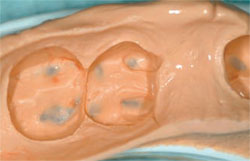 | 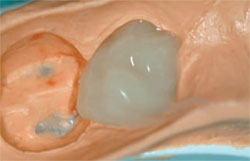 | |
| Figure 5 The preoperative AlgiNot impression matrix | Figure 6 The AlgiNot impression matrix loaded with Fill-In temporary material. | |
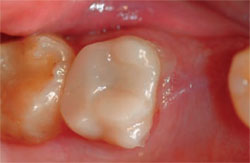 | 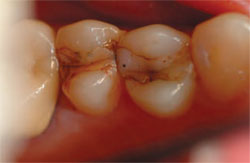 | |
| Figure 7 The preoperative view of tooth No. 16 and Fill-In temporary. Note the remarkable detail in the temporary delivered using AlgiNot. | Figure 8 Preoperative views of large failed restorations on teeth Nos. 14 and 15. | |
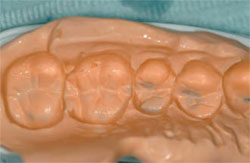 | 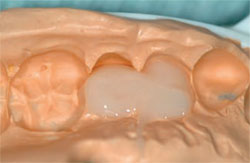 | |
| Figures 9 The preoperative AlgiNot impression matrix. | Figure 10 The preoperative AlgiNot impression matrix loaded with Fill-In temporary material. | |
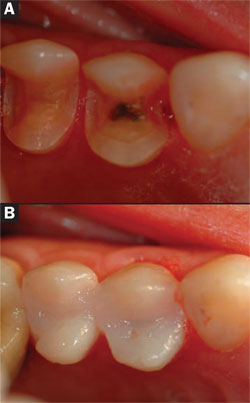 | ||
| Figure 11A and 11B Preoperative views of teeth Nos. 14 and 15 and the Fill-In temporary. Note the remarkable detail in the temporary delivered using AlgiNot, which even captured the fracture of the original tooth structure. |



